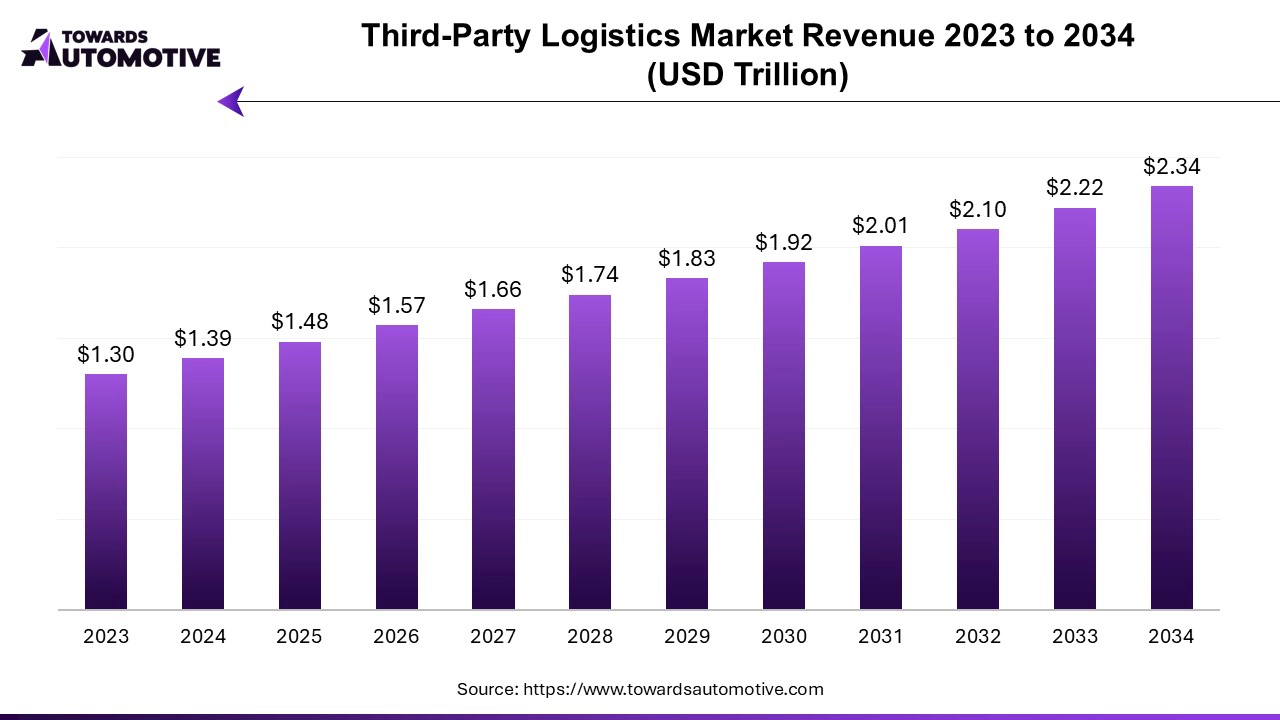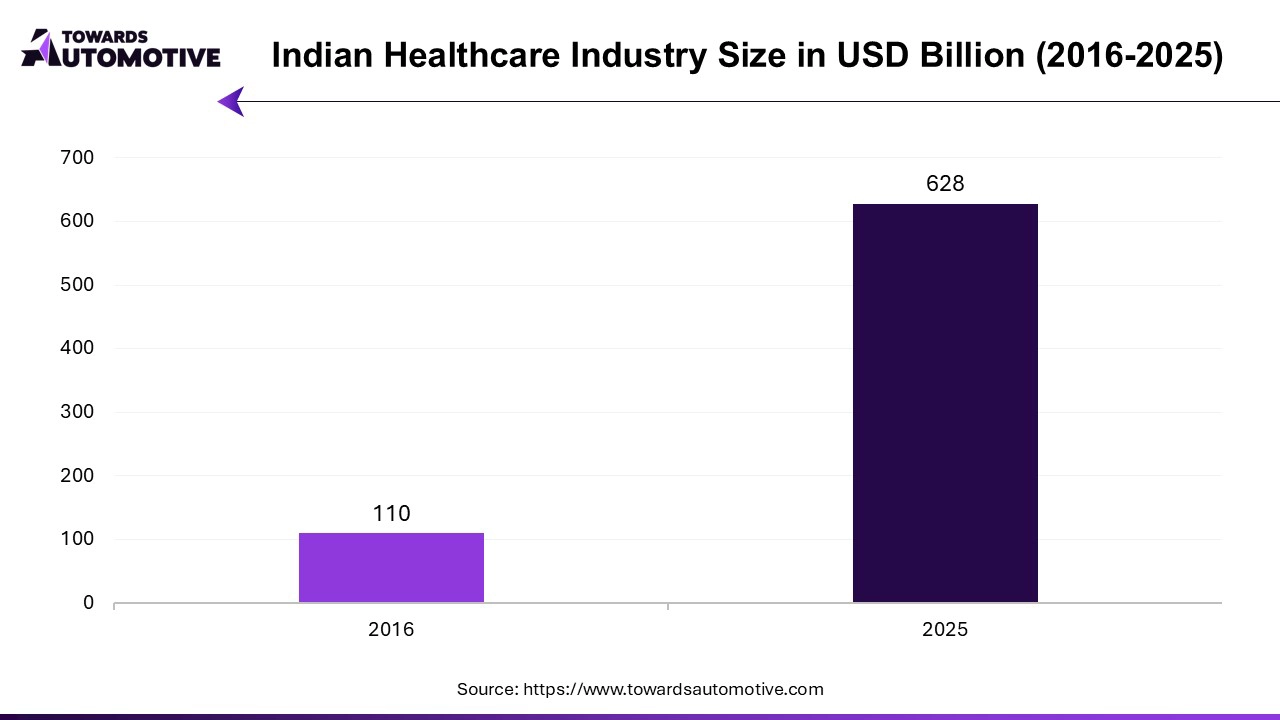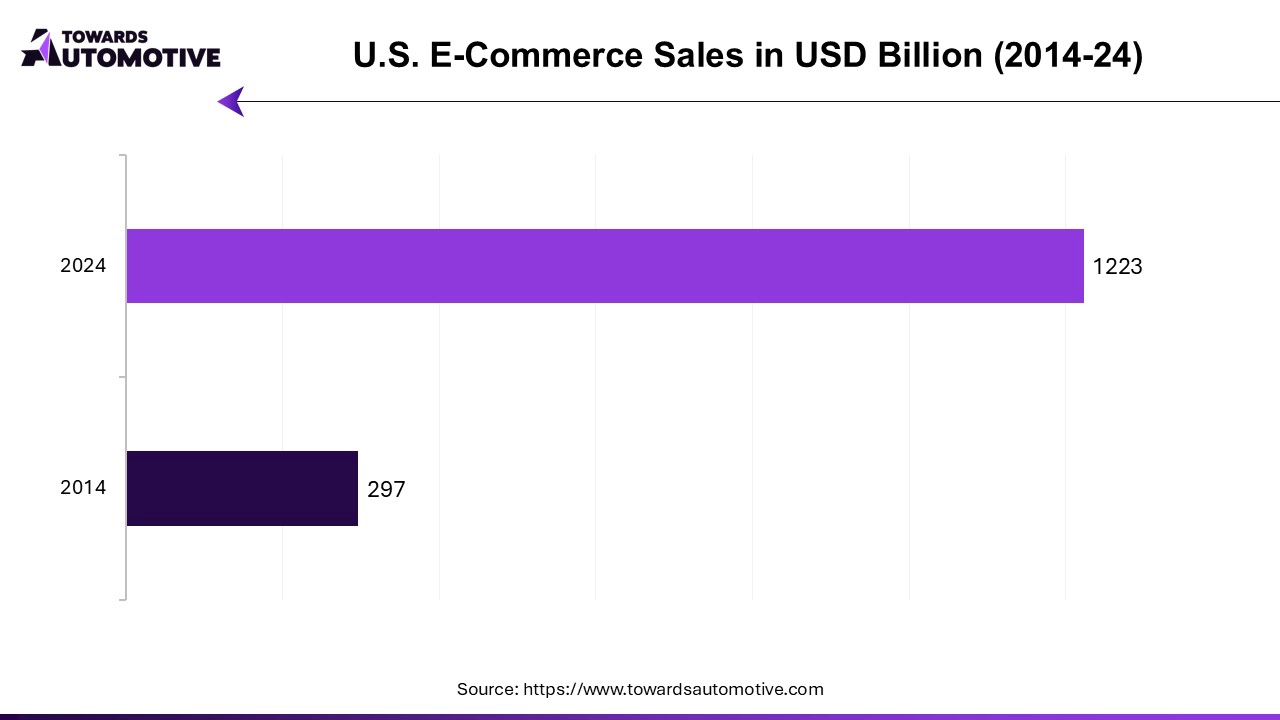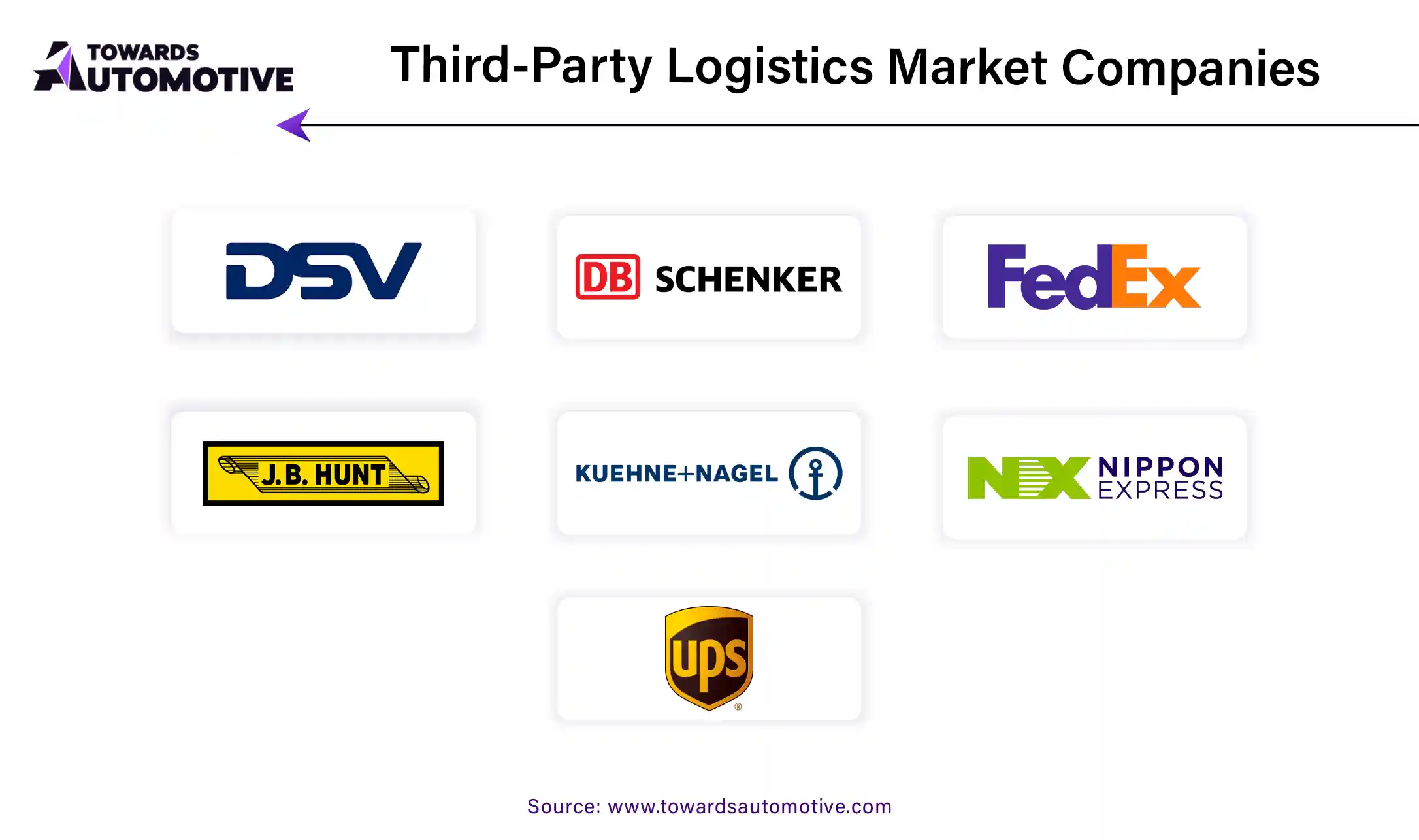April 2025

Senior Research Analyst

Reviewed By
The global third-party logistics market is projected to reach USD 2.34 trillion by 2034, growing from USD 1.48 trillion in 2025, at a CAGR of 5.47% during the forecast period from 2025 to 2034.

The third-party logistics market has become a crucial component of the global supply chain, driven by the increasing complexity of logistics and the growing demand for efficient, cost-effective solutions. Companies are increasingly outsourcing logistics functions to specialized providers to streamline their operations and focus on core business activities. This trend is fueled by the rise of e-commerce, which has heightened the need for efficient inventory management, warehousing, and transportation services.
Additionally, advancements in technology, such as automation and data analytics, have enabled 3PL providers to optimize their services, improve supply chain visibility, and enhance customer satisfaction. The integration of sophisticated tracking systems allows businesses to monitor shipments in real-time, minimizing delays and improving overall efficiency. Moreover, the growing emphasis on sustainability is prompting 3PL companies to adopt greener practices, such as utilizing eco-friendly packaging and optimizing delivery routes to reduce carbon emissions.
The market is further supported by expanding global trade and increasing cross-border e-commerce activities, necessitating reliable logistics solutions to manage diverse and complex supply chains. As businesses continue to seek flexibility, scalability, and specialized expertise, the 3PL market is poised for significant growth, offering various services tailored to meet the evolving needs of different industries.
AI plays a transformative role in the Third-Party Logistics market by enhancing operational efficiency, improving decision-making, and optimizing supply chain processes. One of the key applications of AI in 3PL is predictive analytics, which allows logistics providers to forecast demand more accurately. By analyzing historical data, market trends, and seasonal patterns, AI algorithms can help companies anticipate fluctuations in demand, enabling them to optimize inventory levels and reduce stockouts or overstock situations.
Additionally, AI-powered automation improves warehouse management and order fulfillment. Robotics and automated systems, guided by AI, can streamline picking, packing, and sorting processes, reducing labor costs and increasing speed and accuracy. AI also enhances route optimization for transportation, considering factors such as traffic patterns, weather conditions, and delivery time windows to determine the most efficient routes. This leads to reduced transportation costs and improved delivery times.
Furthermore, AI-driven chatbots and virtual assistants enhance customer service by providing real-time information on shipment status and handling inquiries promptly. This improves the customer experience and fosters loyalty.
The growing development in the healthcare sector significantly drives the growth of the Third-Party Logistics market by increasing the demand for specialized logistics solutions that cater to the unique needs of medical products and services. As healthcare systems evolve and expand, there is a rising need for efficient supply chain management to ensure the timely delivery of pharmaceuticals, medical devices, and other essential healthcare supplies. 3PL providers are uniquely positioned to meet these demands through their expertise in handling complex logistics operations, including warehousing, transportation, and distribution of temperature-sensitive and regulated products.
One of the critical drivers of this growth is the increasing reliance on just-in-time inventory practices within healthcare facilities. Hospitals and clinics aim to minimize inventory costs while ensuring they have access to critical supplies when needed. 3PL providers can offer tailored solutions that optimize inventory management, thus improving operational efficiency and reducing waste. Additionally, the rise of e-commerce in the healthcare space, especially during the pandemic, has led to a surge in demand for direct-to-consumer shipping and home delivery services, further necessitating robust logistics support.
Furthermore, advancements in technology, such as track-and-trace systems and real-time monitoring, allow 3PL companies to provide enhanced visibility and compliance with regulatory standards in the healthcare sector. This capability is crucial for maintaining the integrity of sensitive medical products and ensuring adherence to safety regulations.

The Third-Party Logistics market faces several restraints that can hinder its growth. One major challenge is the increasing complexity of global supply chains, which can lead to inefficiencies and higher operational costs. Additionally, regulatory compliance and the need for adherence to varying international standards can pose significant hurdles for 3PL providers. Moreover, the shortage of skilled labor in logistics and transportation sectors exacerbates challenges in service delivery. Fluctuating fuel prices can also impact transportation costs, making it difficult for 3PL companies to maintain competitive pricing. These factors collectively constrain the growth potential of the 3PL market.
The integration of automation and robotics in warehousing is revolutionizing the Third-Party Logistics market by creating significant opportunities for efficiency and cost savings. Automated systems, such as robotic picking and packing solutions, enhance operational efficiency by reducing manual labor requirements and minimizing human error. This leads to faster order fulfillment and increased accuracy in inventory management. As a result, 3PL providers can meet the growing demand for quicker delivery times, which is especially crucial in the era of e-commerce.
Moreover, automation allows for better space utilization in warehouses, optimizing storage capacity and reducing overhead costs. Advanced technologies, including automated guided vehicles (AGVs) and drones, facilitate seamless movement of goods within warehouses, further streamlining operations. This not only enhances productivity but also allows 3PL companies to handle higher volumes of orders without a proportional increase in labor costs.
Additionally, the data analytics capabilities associated with automated systems provide valuable insights into inventory levels and operational performance, enabling 3PL providers to make informed decisions and improve service offerings. As businesses increasingly seek efficient and scalable logistics solutions, the integration of automation and robotics will be a key driver of growth in the 3PL market, positioning providers to better serve their clients and adapt to changing market dynamics.
The domestic transportation management (DTM) segment held the largest share of the market. Domestic Transportation Management (DTM) plays a crucial role in driving the growth of the Third-Party Logistics market by streamlining logistics operations and enhancing efficiency for businesses across various sectors. As companies increasingly seek to optimize their supply chains, DTM provides the necessary framework for effectively managing the movement of goods within a country. By leveraging DTM services, businesses can improve their operational agility, reduce transportation costs, and enhance delivery performance, making them more competitive in the marketplace.
One of the primary advantages of DTM is its ability to integrate various transportation modes, enabling companies to select the most efficient and cost-effective options for their specific needs. This integration fosters better coordination between freight carriers, ensuring that shipments are delivered on time and in optimal conditions. Moreover, DTM utilizes advanced technology, such as Transportation Management Systems (TMS), which facilitate real-time tracking and visibility of shipments. This transparency allows businesses to make informed decisions, respond swiftly to disruptions, and optimize their transportation routes.
Furthermore, the growing demand for e-commerce and rapid delivery services has placed additional pressure on companies to enhance their domestic logistics capabilities. DTM addresses these challenges by enabling businesses to scale their operations efficiently while maintaining high service levels. As a result, companies are increasingly outsourcing their transportation management to 3PL providers, who specialize in DTM, thereby fueling the growth of the 3PL market. The shift toward e-commerce, coupled with the need for effective domestic logistics solutions, ensures that DTM remains a key driver of growth in the Third-Party Logistics sector.
The roadways segment led the industry. Roadways significantly drive the growth of the Third-Party Logistics market by providing a vital and efficient means of transporting goods across various distances. The extensive and flexible nature of roadway networks allows for the seamless movement of products from manufacturers to distribution centers and ultimately to consumers. As businesses increasingly seek to enhance their supply chain operations, the reliance on road transportation has become paramount. Roadways facilitate the last-mile delivery process, which is crucial for meeting the rising demand for fast and reliable shipping services, especially in the burgeoning e-commerce sector.
Moreover, the advantages of roadway transportation include lower costs and improved accessibility compared to other modes such as air or rail. This cost-effectiveness makes it an attractive option for businesses looking to manage logistics expenses while ensuring timely deliveries. Additionally, road transportation is versatile, capable of accommodating various types of cargo, from perishable goods to heavy machinery, thus broadening the scope of services offered by 3PL providers.
Furthermore, advancements in technology, such as GPS tracking and route optimization software, have enhanced the efficiency of roadway logistics. These innovations enable real-time tracking of shipments, better route planning, and reduced delivery times, all of which contribute to improved customer satisfaction. As urbanization continues to rise, the demand for efficient and reliable road-based logistics solutions will only increase, propelling the growth of the 3PL market. Ultimately, the flexibility, cost-effectiveness, and technological integration associated with roadway transportation make it a cornerstone of the Third-Party Logistics industry, fostering its expansion in an increasingly competitive marketplace.
The manufacturing sector segment held the highest revenue share of the industry. The manufacturing sector plays a pivotal role in driving the growth of the Third-Party Logistics market, primarily by increasing demand for efficient supply chain management and logistics solutions. As manufacturers focus on optimizing their operations, they often turn to 3PL providers to streamline their logistics processes. This partnership allows manufacturers to concentrate on their core competencies production and innovation while outsourcing transportation, warehousing, and distribution functions to specialized logistics firms.
With the rise of global supply chains, manufacturers are increasingly relying on 3PL services to handle complex logistics challenges, such as managing international shipping, compliance with trade regulations, and navigating the intricacies of customs clearance. 3PL providers bring expertise in these areas, enabling manufacturers to reduce lead times and improve overall efficiency. Additionally, as manufacturers adopt just-in-time production methodologies, the need for reliable and responsive logistics partners becomes even more critical.
Moreover, the growing trend of customization in manufacturing has led to an increase in product variety, further complicating logistics operations. 3PL providers can offer flexible warehousing solutions and specialized handling capabilities, ensuring that manufacturers can meet diverse customer demands without incurring significant overhead costs. The integration of advanced technologies, such as data analytics and inventory management systems, allows 3PL firms to provide real-time visibility and better decision-making support, enhancing supply chain resilience.
As global competition intensifies, manufacturers are increasingly seeking to enhance their operational efficiency and responsiveness, making 3PL partnerships essential for sustained growth and competitiveness.

Asia Pacific dominated the third-party logistics market. Government initiatives, urbanization and population growth, and technological advancements significantly drive the growth of the Third-Party Logistics market in the Asia-Pacific (APAC) region. Governments across APAC are actively investing in infrastructure development, including transportation networks, ports, and warehousing facilities, to enhance supply chain efficiency and facilitate trade. These initiatives create a conducive environment for 3PL providers, enabling them to expand their services and reach more customers.
Additionally, rapid urbanization and increasing population density in major cities lead to a surge in demand for efficient logistics solutions. As urban areas expand, businesses require effective distribution networks to manage the flow of goods and ensure timely deliveries to consumers. This growing demand for last-mile delivery services positions 3PL providers as essential partners for businesses navigating the complexities of urban logistics.
Moreover, technological advancements play a crucial role in shaping the 3PL landscape in APAC. The integration of technologies such as artificial intelligence, big data analytics, and the Internet of Things (IoT) empowers logistics companies to optimize their operations, enhance visibility throughout the supply chain, and improve overall customer service.
By leveraging these technologies, 3PL providers can streamline processes, reduce operational costs, and adapt quickly to changing market demands. Furthermore, the growing e-commerce sector in APAC, fueled by consumer preferences for online shopping, amplifies the need for robust logistics support, further propelling the growth of the 3PL market.
North America is expected to grow with a significant CAGR during the forecast period. Rapid e-commerce growth, supply chain resilience, and increased investment in the logistics industry are pivotal factors driving the expansion of the Third-Party Logistics market in North America. The surge in online shopping, accelerated by changing consumer behavior and the recent global pandemic, has transformed the retail landscape, resulting in heightened demand for efficient and reliable logistics solutions.
E-commerce businesses rely on 3PL providers to manage warehousing, inventory, and distribution, enabling them to meet customer expectations for fast and accurate deliveries. As consumers increasingly seek convenient shopping experiences, 3PL providers play a critical role in facilitating seamless order fulfillment and last-mile delivery, thereby enhancing customer satisfaction.
Additionally, the emphasis on supply chain resilience has gained prominence in light of recent disruptions, such as the COVID-19 pandemic and geopolitical tensions. Companies are now prioritizing flexible and adaptive supply chain strategies to mitigate risks and ensure continuity. 3PL providers are uniquely positioned to offer the agility and scalability required to navigate these challenges, making them invaluable partners for businesses aiming to strengthen their supply chains.
Furthermore, increased investment in the logistics industry, driven by both public and private sectors, is fueling technological advancements and infrastructure development. Innovations such as automation, artificial intelligence, and data analytics enhance operational efficiency and enable 3PL providers to offer more sophisticated services. As logistics capabilities evolve, businesses are more likely to outsource their logistics functions to focus on core competencies, thus driving further growth in the 3PL market.


By Service
By Transport
By End-Use
By Region
April 2025
March 2025
March 2025
February 2025
Dr. Arjun Patel is a distinguished expert in the automotive industry, holding advanced degrees in Automotive Engineering and Mechanical Engineering. His expertise spans automotive market dynamics, technological advancements, and sustainable practices. Dr. Patel excels in conducting in depth research and analysis on market trends, consumer preferences, and the economic implications within the automotive sector. He is renowned for his insightful publications on topics such as electric vehicles, autonomous driving technologies, and the evolution of sustainable transportation solutions. Dr. Patels research contributions have significantly advanced understanding in the field, earning him recognition as a leading authority in automotive research and analysis.
We offer automotive expertise for market projections and customizable research, adaptable to diverse strategic approaches.
Contact Us